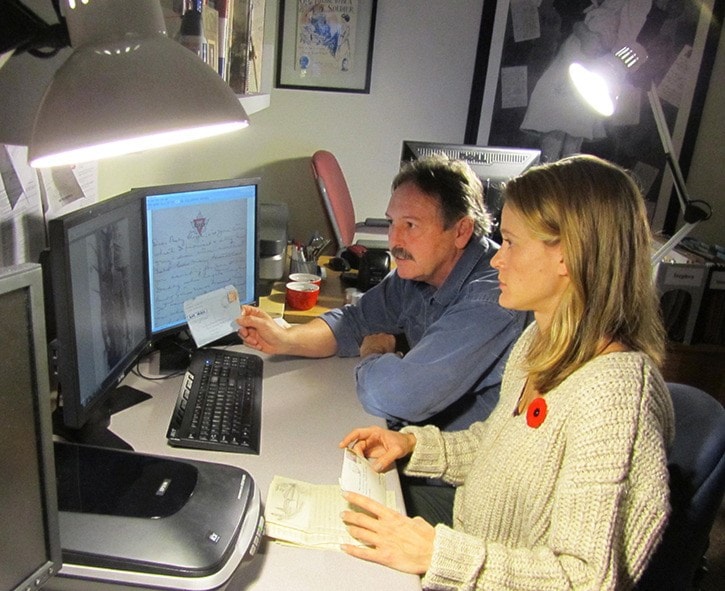Sixteen years into his “small-scale project,” Dr. Stephen Davies and his students have put more than 25,000 letters from soldiers online for the public at www.canadaletters.ca.
“It has taken off as a national project,” said Davies, who teaches First World War history at Vancouver Island University in Nanaimo.
Among the letters are missives from Port Alberni resident and soldier George Morton Bird.
The bulk of Bird’s letters were sent while in training, long before he hit the Western Front with the 19th Battalion, 6th Infantry Brigade, 2nd Canadian Division.
On Sept. 28, 1916, Bird wrote to his father describing the German barrage at the Somme as “awful.”
“A machine gun bullet went through my helmet and grazed my head, and also pieces of my helmet or bullet hit me in the shoulder. I laid in a shell hole for about ten seconds and decided to go on, when I saw I wasn’t badly hurt. As it turned out I did the best thing I could have done as Fritz shelled us fierce and the wounded out behind us got hit very bad,” Bird wrote.
“J Thomson and Cole from Port Alberni were both killed I believe though I can’t be quite certain. It certainly is hell, but I think Fritz (the Germans) gets it far worse than we do. We had two or three prisoners (wounded) come out with us.
“You should have seen them duck when one of their shells came over when we were coming out. The shell fire and machine gun fire we had to go through is impossible to describe. The whole country around there is simply blasted to pieces …
“I suppose I shouldn’t tell you this but I know it will go no further than you know in safe, and I wanted you to know where I had been in case anything should chance to happen in the future which God being willing I don’t think will,” he wrote.
George Bird was killed in France on May 6, 1917 in the Battle of Arras.
West Coast connection
Among the digitized memorabilia at www.canadaletters.ca are the wartime photos and papers of pioneer Tofino fisherman and lifeboat worker Harold Monks, Sr., who survived the war.
A picture postcard in his collection shows a view of the valley and the inlet—snapped by J. Clegg.
Pictures of Monks at the front with friends like Joe Hamilton and others are followed by a picture of crosses erected at graves of his trench buddies.
A note to the discharged Monks from King George on Buckingham Palace letterhead reads “The Queen and I wish you God-speed and a safe return to your homes and dear ones. A grateful Mother Country is proud of your splendid services characterized by unsurpassed devotion and courage.”
Notes scrawled in his own hand in a black elastic-bound notebook range from battles he fought in (Amiens, Scarpe, Canal du Nord, San Quentin Canal and Cambrai) to jottings from after the war— what kind of fishing boat he was going to need, how much he got for coho, sockeye, spring and other fish varietals.
He also noted the signals for Morse code —something he would use when helping with the telegraph lines to the West Coast in his post-war career.
One of Harold Monks’ friends was gunner Ray Brewster, the son of B.C.’s Premier Harlan Carey Brewster (a former Alberni MLA).
Of three of Ray Brewster’s letters also in the canadaletters.ca collection, one is his note to his sister, a Mrs. Townsend, about his shock after the unexpected notification that their father had died suddenly while in office.
“I have tried in every way possible to get a few weeks leave, but men are scarce now, and it was impossible. I certainly would have liked to get home for a few weeks to help settle things up,” he penned.
Ray Brewster was killed instantly on Nov. 1, 1918 when the gun they were working at doing heavy firing received a direct hit.
Learn from history
Stephen Davies said the letters, photos and paybooks do what books and classrooms can’t.
“I think the letters are the most powerful means of understanding what the war experience encompassed,” he said.
What’s online is about half what has been digitized so far. The project doesn’t receive any government funding, instead relying on donations—and any donations are used to pay students part-time wages to scan, transcribe and upload.
Davies stressed that no items are retained. The project pays to have them picked up, and then returned as soon as they’ve been respectfully scanned and transcribed.
Every day, tweets are sent out from letters and journals relating to the date.
There are also teacher resources online, to encourage classrooms to make the project part of their history learning.
Students in Davies’ First World War classes can participate in field school programs in Belgium and France, where they can reach out and touch the tombstone of soldiers they’ve written biographies for.
In addition to the First World War, the project covers memorabilia from other eras—the Second World War, Korean War, and others.
“We’re proud of what we’ve done— and we want to make Canadians aware that it’s important to preserve (these items) in some form,” Davies said.
Jacqueline Carmichael is a freelance writer, former newspaper editor and author living on the West Coast.
facebook.com/albernivalleynews
